|
|
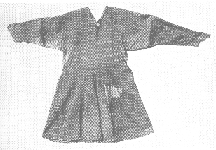
|
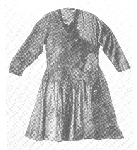
|
A comparative study of extant garments relevant to East Denmark in the mid-to-late 14th Century
By Maggie Forest
Introduction
The garments that remain to this day are of several types, and give a relatively good (but not complete) overview of what garments looked like in period. Generally speaking, a person would wear a kirtle over his shirt, then optional overgarments. These could be open (sleeveless) or closed (short or long sleeved) surcotes. There are other types of garments documented such as cotehardies, garnaches and garde-corps. None of these have survived however. Mantles, hoods and hose have not been included here for the moment, but I intend to expand the document with information on these types of garments too.
In the middle of the century there was a big shift in fashion. While garments earlier had been looser, cut based on simple geometrical shapes, by about 1330 the silhouette on the continent had changed to a closer fitted, more wasteful way of cutting the garments. The garments known as pourpoints, aketons and doublets belong in this category. The sleeve construction changed from a rectangle with the seam under the sleeve, with two gussets for width, into a more fitted sleeve with a sleeve cap. The seam rotated almost a half-turn to go up the back of the arm, and width was provided by one (or in some cases more) gussets at the top. The armhole in the garment was correspondingly rounded to provide a more comfortable fit. This particular change also gave rise to the 'grande assiette' sleeve, which seems to have been used both for the new line of garment (Charles de Blois' pourpoint) and older style kirtles (Margrete's gown).
This style of clothing moved relatively slowly across the continent, and seems to have reached Denmark by 1360-70. The Herjolfsnes garments seem to belong to this transitional phase, although they can be dated to the very end of the 14th C and even into the 15th. We can assume that they still belong in this study based on the slow spread of fashions - it would have taken that long for this new line to have reached Norway and then Greenland.
This document is organised into two sections. The first consists of a listing of individual garments with thumbnails. The list is organised into groups based on construction and use. Each thumbnail is clickable, leading to a page giving as much information as I can provide, along with bibliographical information.
The second part is a table showing individual topics for comparison. Clicking on the topics will bring up a page showing comparative data for all relevant garments.
Garment terms
The garments of the period were many, and the terms are often difficult to connect to the garments worn in artwork. For the purposes of this document, I've used 'kirtle' to denote the basic garment, worn on top of the shirt or smock, but below anything else. There are several types of kirtles, the basic ones, the split kirtle (blad kyrtil), the two-coloured kirtle (halfskiptan kyrtill) and the fitted kirtle found in the Herjolfsnes finds. The latter represents a new sophistication in the cutting of garments, although the older geometrical garments remained in use for some time.
Outer garments are described here as surcotes. They are of two types: open, or sleeveless, and closed, or sleeved - either short or long sleeves. Often these garments, or some of them, are described as Cotehardies. In my opinion a cotehardie is a particular type of surcote that is very close fitting, and seems to always be buttoned or laced. "Hardie" in Medieval French means 'daring'; Charles the Bold is known in French as Charles le Hardi. The name points to the close-fitting nature of the garment, making the buttoning/lacing necessary to get into it. There is some evidence (see Stella Mary Newton's Fashion in the Age of the Black Prince for references) that early on connects it with outdoor pursuits, and the buttoning or lacing down the front makes it very easy to get out of a dirty garment.
I'm also listing some more advanced garments, with the grande assiette style sleeve and in the case of the male garment, a shorter and tighter silhouette. The pourpoint of Charles de Blois represents yet another martial garment accepted into daily wear, and the style appears to have been common in Europe by the 1330's, while it only reached Denmark in the 1360-70's.
Children's clothing seems very much like the adults' of the time, albeit perhaps a little simpler - although it is hard to say with the limited number available. I have nonetheless listed the children's garments separately. Finally, the arming cotes of Charles and Edward have been included for completeness.
|
|

|

|
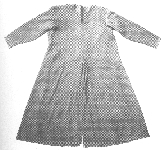
|
| Herjolfsnes 41 |
Also the following garments: Herjolfsnes 34, Herjolfsnes 36, Herjolfsnes 40, Herjolfsnes 46, Herjolfsnes 49, Herjolfsnes 53

|
||||
| Herjolfsnes 38 | Herjolfsnes 39 | Herjolfsnes 42 | Herjolfsnes 43 | Herjolfsnes 45 |
Also the following garments: Herjolfsnes 35, Herjolfsnes 47, Herjolfsnes 50, Herjolfsnes 51, Herjolfsnes 56
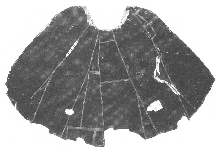
|
|
| Herjolfsnes 37 |
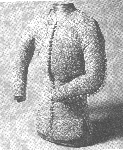
|
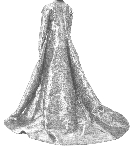
|

|
| Herjolfsnes 44 |
Also the following garments: Herjolfsnes 48, Herjolfsnes 61
Ronbjerg is listed here as a mi-parti kirtle. There is no definite proof that this was the case, but the fact that the garment had a mid-front seam suggests that it might have been two-coloured.
Similarly, I have listed St. Birgitta's "cloak" as a surcote ouvert. There is in fact no information at all about whether it had sleeves or not - the only surviving parts of the original cote are the skirts. Some conjecture can be made about the overall look of the body of the garment, but not about the sleeves.
Finally, not all the garments from Herjolfsnes are listed individually here, either because they were to fragmented to provide overall data or because they are later. The later garments include the pleated garments, and those with a stand-up collar. Of the fragmented garments, some data has been included in sections where the information is relevant.
(Note: I will in fact add the collared Herjolfsnes garments, as well as the relevant info of finds from London. If there is additional data available about garments, or if there are garments out there I'm not aware of, the information would be highly appreciated.)
Ancient Danish Textiles from Bogs and Burials, Margrethe Hald, The National Museum of Denmark, Copenhagen 1980.
Bockstensmannen och hans dräkt, Margareta Nockert m.fl. Hallands länsmuseer, Halmstad och Varberg, 1997.
Drotting Margaretas gyllene kjortel i Uppsala Domkyrka (The Golden Gown of Queen Margareta in Uppsala Cathedral), Agnes Geijer, Anne Marie Franzen, Margareta Nockert, Kungliga Vitterhets Historie och Antikvitets Akademien, Stockholm 1994
Arms and Armour of the Medieval Knight, by David Edge and John Miles Paddock, published by Saturn Books in 1996.
Chapter IV, The Costumes in Buried Norsemen at Herjolfsnes, by Poul Nörlund. Bind LXVII - Meddelelser om Grønland. Kommissionen for ledelsen af de Geologiske og geografiske undersøgelser i Grønland, Copenhagen 1924.
Lille Margrete og andre børn i Middelalderen, ed. Connie Hinch. Danmarks national museum. (leaflet of an exhibition)